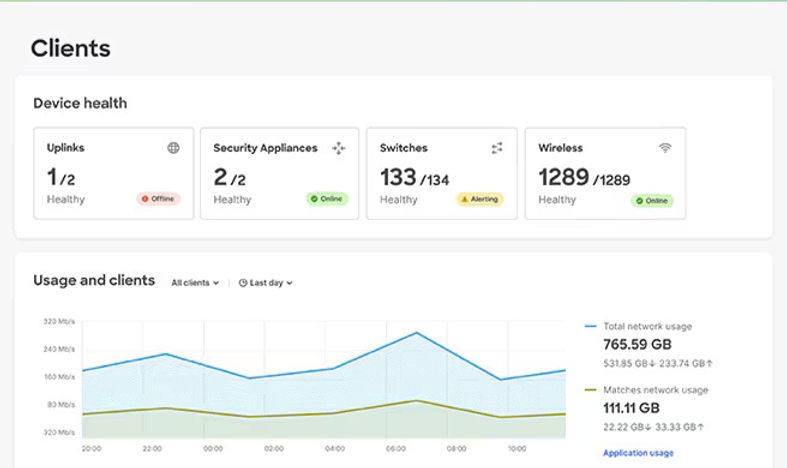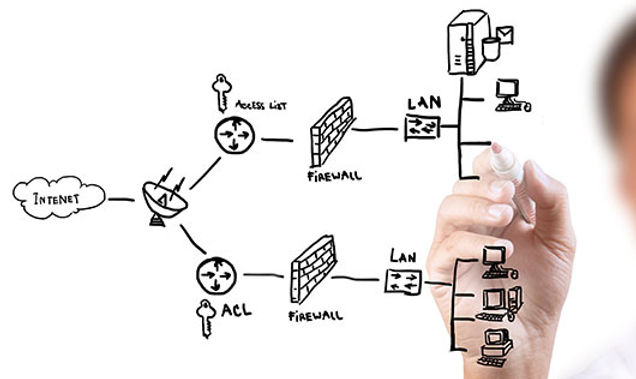- BTI Group
- IT Products Services Articles
- 5 min read
Understanding Network Virtualization: A Business Perspective

Learn the ins and outs of network virtualization & how adopting it can become a strategic advantage that can give you the upper hand in your organization.
Understand everything from the basic principles, the latest strategies, and get priceless insights, and business applications from Eric Brackett, Founder and President of BTI Communications Group.
What is Network Virtualization?
Network virtualization is the process of transforming a traditional hardware-based network into a software-based network. This involves decoupling network functions, hardware resources, and software resources from their physical hardware, allowing them to be delivered as virtual networks.
The primary goal of network virtualization is to create a flexible, scalable, and efficient network environment that can adapt to changing business needs.
Types of Network Virtualization
There are two main types of network virtualization: external and internal network virtualization.
External Network Virtualization
External network virtualization combines multiple physical networks into one virtual network or divides one physical network into multiple virtual networks. This type of virtualization allows businesses to manage complex network environments more efficiently, providing better resource utilization and enhanced security.
Internal Network Virtualization
Internal network virtualization occurs within a single server. It involves creating virtual networks that run within a server, improving its efficiency by isolating applications or running different operating systems on the same hardware. This approach is particularly beneficial for maximizing server resources and enhancing application performance.
The Benefits of Network Virtualization
Cost Reduction
One of the most significant advantages of network virtualization is cost reduction. By virtualizing network functions, businesses can reduce their reliance on expensive proprietary hardware. Instead, they can utilize standard servers and other less costly hardware, which can lead to substantial savings. A study by ACG Research indicates that network operators who fully virtualize their networks can achieve up to 44% of total cost of ownership (TCO) savings.
Improved Flexibility and Scalability
Virtualization in computer networks allows businesses to quickly scale their network resources up or down based on demand. This flexibility is crucial for businesses that experience fluctuating workloads or need to rapidly deploy new applications and services. In addition, virtual networks can be configured and reconfigured without the need for physical hardware changes, providing a highly adaptable network environment.


Enhanced Security
With network virtualization, businesses can implement more robust security measures. Virtual networks can be isolated from one another, reducing the risk of a security breach spreading across the entire network. Additionally, security policies can be applied at a more granular level, ensuring that sensitive data and applications are better protected.
Simplified Network Management
Managing a virtualized network is simpler and more efficient than managing a traditional hardware-based network. Network administrators can use software tools to monitor and manage virtual networks, automate routine tasks, and quickly address any issues that arise.
This streamlined approach to network management can lead to improved operational efficiency and reduced downtime.
Faster Service Deployment
Network virtualization software enables businesses to deploy new services and applications more quickly. Since virtual networks can be created and modified through software, there is no need to wait for physical hardware to be installed or configured.
This speed and agility are particularly valuable in today’s fast-paced business environment, where being able to quickly respond to market changes can provide a competitive edge.
Better Resource Utilization
Virtual networks allow for better utilization of existing network resources. By consolidating multiple networks into one virtual network or dividing a single network into multiple virtual networks, businesses can ensure that their resources are used more efficiently.
This transformation is critical to keep up and meet the high expectations of modern consumers.

Real-World Applications of Network Virtualization Technologies

Telecommunications
In the telecommunications industry, network virtualization solutions are revolutionizing how service providers operate. By virtualizing network functions such as routers, firewalls, and load balancers, telecom companies can deliver services more efficiently and at a lower cost.
Before starting your plan, you should ask yourself:

Healthcare
Network virtualization tools are also making a significant impact in the healthcare sector. Virtual networks enable healthcare providers to manage patient data, deploy telehealth services, and support advanced medical applications such as remote surgery and real-time patient monitoring securely and efficiently.
This technology is helping healthcare organizations improve patient care while reducing costs.

Financial Services
In the financial services industry, network virtualization provides enhanced security and flexibility. Financial institutions can use virtual networks to isolate sensitive transactions, protect against cyber threats, and quickly adapt to regulatory changes.
This capability is essential for maintaining trust and compliance in an increasingly digital financial landscape.

Retail
Retail businesses are leveraging network virtualization to improve their operations and enhance the customer experience.
Virtual networks support advanced retail applications such as inventory management, customer analytics, and personalized marketing. By optimizing their network infrastructure, retailers can deliver better service and drive sales growth.
The Cost of Implementing Network Virtualization Solutions
Implementing network virtualization involves several cost components, including software licensing, hardware upgrades, and professional services. Here is a breakdown of potential costs for a typical mid-sized business in the US:
- Software Licensing: Network virtualization software can range from $1,000 to $5,000 per server, depending on the features and capabilities required.
- Hardware Upgrades: While network virtualization reduces the need for proprietary hardware, businesses may still need to invest in high-performance servers and networking equipment. This can cost between $10,000 and $50,000.
- Professional Services: Hiring experts to design, implement, and manage a virtualized network can cost between $5,000 and $20,000, depending on the complexity of the project.
Despite these upfront costs, the long-term savings and operational benefits of network virtualization often outweigh the initial investment.
How to Choose the Right Network Virtualization Solution
When selecting a network virtualization solution, businesses should consider the following factors:
Compatibility
Ensure that the virtualization solution is compatible with your existing network infrastructure and can integrate seamlessly with your current hardware and software.
Scalability
Choose a solution that can scale with your business as it grows. This includes the ability to support increasing network traffic, additional virtual networks, and new applications.
Security
Look for a solution that offers robust security features, including network isolation, encryption, and advanced threat detection and prevention.
Support and Training
Select a vendor that provides comprehensive support and training services. This will help ensure that your IT team can effectively manage and maintain the virtualized network.
Total Cost of Ownership
Consider the total cost of ownership, including initial setup costs, ongoing maintenance, and potential savings. Evaluate the ROI to ensure that the investment is justified.
The Future of Network Virtualization Services
5G and Edge Computing
The rollout of 5G networks and the growth of edge computing are driving further advancements in network virtualization. These technologies require highly flexible and scalable network infrastructures, making network virtualization an essential component of next-generation networks.
Artificial Intelligence and Automation
Artificial intelligence (AI) and automation are increasingly being integrated into network virtualization solutions. AI can help optimize network performance, predict, and mitigate potential issues, and enhance security.
Automation allows for more efficient network management and faster deployment of new services.
Software-Defined Networking (SDN)
Software-defined networking (SDN) is closely related to network virtualization. SDN separates the control plane from the data plane, allowing for centralized management of network resources.
This approach provides greater flexibility, scalability, and security, making it a natural complement to network virtualization.
Network Function Virtualization (NFV)
Network function virtualization (NFV) takes network virtualization a step further by virtualizing entire network functions. NFV allows service providers to run network functions on standard servers, reducing costs and improving flexibility.
This trend is expected to continue as more businesses adopt NFV to streamline their network operations.
Conclusion
Network virtualization is transforming the way businesses operate, offering numerous benefits such as cost reduction, improved flexibility, enhanced security, simplified management, faster service deployment, and better resource utilization.
If you’re considering network virtualization for your business, or you need help evaluating your current network infrastructure, BTI can help you understand your specific needs, and choose a solution that aligns with your goals.
Let’s work together to build a network that supports your business objectives and drives success! Contact us today to schedule your free business assessment and take the next steps towards unmatched efficiency, reduced costs, and world-class IT solutions!



